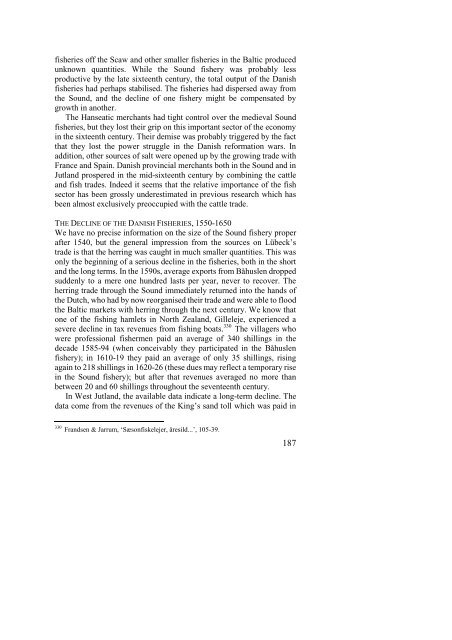The North Atlantic Fisheries, 1100-1976 - University of Hull
The North Atlantic Fisheries, 1100-1976 - University of Hull
The North Atlantic Fisheries, 1100-1976 - University of Hull
You also want an ePaper? Increase the reach of your titles
YUMPU automatically turns print PDFs into web optimized ePapers that Google loves.
fisheries <strong>of</strong>f the Scaw and other smaller fisheries in the Baltic produced<br />
unknown quantities. While the Sound fishery was probably less<br />
productive by the late sixteenth century, the total output <strong>of</strong> the Danish<br />
fisheries had perhaps stabilised. <strong>The</strong> fisheries had dispersed away from<br />
the Sound, and the decline <strong>of</strong> one fishery might be compensated by<br />
growth in another.<br />
<strong>The</strong> Hanseatic merchants had tight control over the medieval Sound<br />
fisheries, but they lost their grip on this important sector <strong>of</strong> the economy<br />
in the sixteenth century. <strong>The</strong>ir demise was probably triggered by the fact<br />
that they lost the power struggle in the Danish reformation wars. In<br />
addition, other sources <strong>of</strong> salt were opened up by the growing trade with<br />
France and Spain. Danish provincial merchants both in the Sound and in<br />
Jutland prospered in the mid-sixteenth century by combining the cattle<br />
and fish trades. Indeed it seems that the relative importance <strong>of</strong> the fish<br />
sector has been grossly underestimated in previous research which has<br />
been almost exclusively preoccupied with the cattle trade.<br />
THE DECLINE OF THE DANISH FISHERIES, 1550-1650<br />
We have no precise information on the size <strong>of</strong> the Sound fishery proper<br />
after 1540, but the general impression from the sources on Lübeck’s<br />
trade is that the herring was caught in much smaller quantities. This was<br />
only the beginning <strong>of</strong> a serious decline in the fisheries, both in the short<br />
and the long terms. In the 1590s, average exports from Båhuslen dropped<br />
suddenly to a mere one hundred lasts per year, never to recover. <strong>The</strong><br />
herring trade through the Sound immediately returned into the hands <strong>of</strong><br />
the Dutch, who had by now reorganised their trade and were able to flood<br />
the Baltic markets with herring through the next century. We know that<br />
one <strong>of</strong> the fishing hamlets in <strong>North</strong> Zealand, Gilleleje, experienced a<br />
severe decline in tax revenues from fishing boats. 330 <strong>The</strong> villagers who<br />
were pr<strong>of</strong>essional fishermen paid an average <strong>of</strong> 340 shillings in the<br />
decade 1585-94 (when conceivably they participated in the Båhuslen<br />
fishery); in 1610-19 they paid an average <strong>of</strong> only 35 shillings, rising<br />
again to 218 shillings in 1620-26 (these dues may reflect a temporary rise<br />
in the Sound fishery); but after that revenues averaged no more than<br />
between 20 and 60 shillings throughout the seventeenth century.<br />
In West Jutland, the available data indicate a long-term decline. <strong>The</strong><br />
data come from the revenues <strong>of</strong> the King’s sand toll which was paid in<br />
330 Frandsen & Jarrum, ‘Sæsonfiskelejer, åresild...’, 105-39.<br />
187















